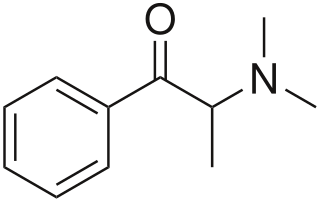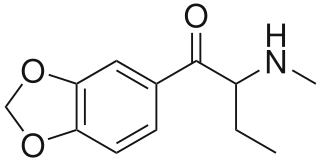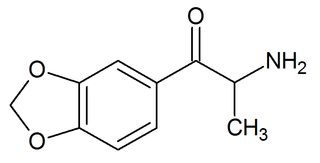
Metamfepramone is a stimulant drug of the phenethylamine, and cathinone chemical classes. Dimethylcathinone was evaluated as an appetite suppressant and for the treatment of hypotension, but was never widely marketed.

Butylone, also known as β-keto-N-methylbenzodioxolylbutanamine (βk-MBDB), is an entactogen, psychedelic, and stimulant psychoactive drug of the phenethylamine chemical class. It is the β-keto analogue of MBDB and the substituted methylenedioxyphenethylamine analogue of buphedrone.

Methylone is an empathogen and stimulant psychoactive drug. It is a member of the substituted amphetamine, substituted cathinone and substituted methylenedioxyphenethylamine classes.

Ethylone, also known as 3,4-methylenedioxy-N-ethylcathinone, is a recreational designer drug classified as an entactogen, stimulant, and psychedelic of the phenethylamine, amphetamine, and cathinone chemical classes. It is the β-keto analogue of MDEA ("Eve"). Ethylone has only a short history of human use and is reported to be less potent than its relative methylone. In the United States, it began to be found in cathinone products in late 2011.

Methylenedioxypyrovalerone (MDPV) is a stimulant of the cathinone class that acts as a norepinephrine–dopamine reuptake inhibitor (NDRI). It was first developed in the 1960s by a team at Boehringer Ingelheim. Its activity at the dopamine transporter is six times stronger than at the norepinephrine transporter and it is virtually inactive at the serotonin transporter. MDPV remained an obscure stimulant until around 2004 when it was reportedly sold as a designer drug. In the USA, products containing MDPV and labeled as bath salts were sold as recreational drugs in gas stations, similar to the marketing for Spice and K2 as incense, until it was banned in 2011.

α-Pyrrolidinopropiophenone (α-PPP), is a stimulant drug. It is similar in structure to the appetite suppressant diethylpropion and has analogous effects in animals. Little is known about this compound, but it has been detected by laboratories in Germany as an ingredient in "ecstasy" tablets seized by law enforcement authorities. This drug has been found to produce stimulant effects in animals and presumably also produces these effects in humans, based on the context in which it has been found.

1,3-Benzodioxolylbutanamine is an entactogenic drug of the phenethylamine chemical class. It is the α-ethyl analog of MDPEA and MDA and the methylenedioxy analogue of α-ethylphenethylamine.

3,4-Methylenedioxy-N,N-dimethylamphetamine (MDDM) is a lesser-known research chemical. It is also the N,N-dimethyl analog of 3,4-methylenedioxyamphetamine (MDA). MDDM was first synthesized by Alexander Shulgin. In his book PiHKAL , the dosage is unspecified and the duration unknown. MDDM produces only mild effects that are not well characterized in PiHKAL. Very little data exists about the pharmacological properties, metabolism, and toxicity of MDDM. This compound is however occasionally encountered as an impurity in 3,4-methylenedioxy-N-methylamphetamine (MDMA) which has been synthesized by methylation of MDA using methylating reagents such as methyl iodide. An excess of reagent or a reaction temperature that is too high results in some double methylation of the amine nitrogen, yielding MDDM as well as MDMA. The presence of MDDM as an impurity can thus reveal which synthetic route was used to manufacture seized samples of MDMA.

3',4'-Methylenedioxy-α-pyrrolidinopropiophenone (MDPPP) is a stimulant designer drug. It was sold in Germany in the late 1990s and early 2000s as an ingredient in imitation ecstasy (MDMA) pills. It shares a similar chemical structure with α-PPP and MDPV, and has been shown to have reinforcing effects in rats.

4'-Methyl-α-pyrrolidinopropiophenone is a stimulant drug and substituted cathinone. It is structurally very similar to α-PPP, with only one added methyl group in the para position on the phenyl ring. 4-MePPP was sold in Germany as a designer drug in the late 1990s and early 2000s, along with a number of other pyrrolidinophenone derivatives. Although it has never achieved the same international popularity as its better-known relations α-PPP and MDPV, 4-MePPP is still sometimes found as an ingredient of grey-market "bath salt" blends such as "NRG-3".

4'-Methoxy-α-pyrrolidinopropiophenone (MOPPP) is a stimulant designer drug of the pyrrolidinophenone class. It has the potential to produce euphoria, an effect shared with other classical stimulants.

MDAI (5,6-methylenedioxy-2-aminoindane) is a drug developed in the 1990s by a team led by David E. Nichols at Purdue University. It acts as a non-neurotoxic and highly selective serotonin releasing agent (SSRA) in vitro and produces entactogen effects in humans.

3',4'-Methylenedioxy-α-pyrrolidinobutyrophenone (MDPBP) is a stimulant of the cathinone class developed in the 1960s, which has been reported as a novel designer drug. MDPBP is sometimes sold under the name "NRG-1" as a mixture with other cathinone derivatives, including flephedrone, pentylone, MαPPP and its higher homologue MDPV. As with other cathinones, MDPBP has been shown to have reinforcing effects in rats.

α-Pyrrolidinopentiophenone is a synthetic stimulant of the cathinone class developed in the 1960s that has been sold as a designer drug. Colloquially, it is sometimes called flakka. α-PVP is chemically related to pyrovalerone and is the ketone analog of prolintane.

Substituted cathinones, which include some stimulants and entactogens, are derivatives of cathinone. They feature a phenethylamine core with an alkyl group attached to the alpha carbon, and a ketone group attached to the beta carbon, along with additional substitutions. Cathinone occurs naturally in the plant khat whose leaves are chewed as a recreational drug.

4-Methylethcathinone or 4-MEC is a chemical that bears a chemical resemblance to mephedrone. Due to its similarity to mephedrone, it is thought to be a stimulant and entactogen drug of the phenethylamine, amphetamine, and cathinone chemical classes. It has been marketed alone or in mixtures with other substituted cathinones under the name "NRG-2", although other blends such as "NRG-1" may have been more ambiguous with their ingredients.

3,4-Methylenedioxycathinone is an empathogen and stimulant of the phenethylamine, amphetamine, and cathinone classes and the β-keto analogue of MDA.

5-Methylethylone is an empathogen, stimulant and psychedelic drug of the amphetamine, phenethylamine, and cathinone chemical classes. It is structurally related to ethylone, a novel designer drug. Relatively little data exists about the pharmacological properties, metabolism, and toxicity of 5-methylethylone, though it has been sold as a designer drug.

N-Ethylhexedrone (also known as α-ethylaminocaprophenone, N-ethylnorhexedrone, hexen, and NEH) is a stimulant of the cathinone class that acts as a norepinephrine–dopamine reuptake inhibitor (NDRI) with IC50 values of 0.0978 and 0.0467 μM, respectively. N-Ethylhexedrone was first mentioned in a series of patents by Boehringer Ingelheim in the 1960s which led to the development of the better-known drug methylenedioxypyrovalerone (MDPV). Since the mid-2010s, N-ethylhexedrone has been sold online as a designer drug. In 2018, N-ethylhexedrone was the second most common drug of the cathinone class to be identified in Drug Enforcement Administration seizures.

MDPHP (3',4'-Methylenedioxy-α-pyrrolidinohexiophenone) is a stimulant of the cathinone class originally developed in the 1960s, which has been reported as a novel designer drug. In the UK its slang name is monkey dust. It is closely related to the potent stimulant MDPV though with slightly milder effects, and has been used as an alternative in some countries following the banning of MDPV.




















